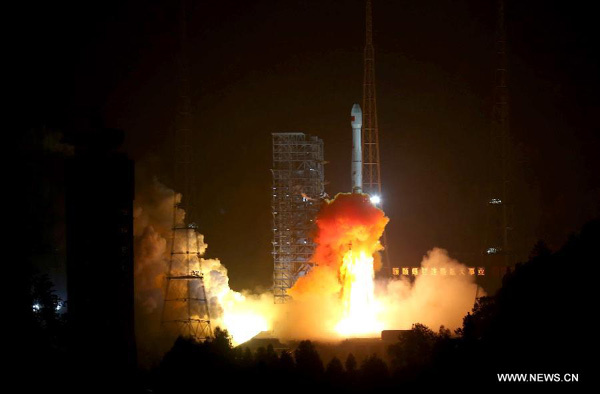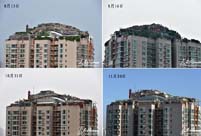 |
| The Long March-3B carrier rocket carrying China's Chang'e-3 lunar probe blasts off from the launch pad at Xichang Satellite Launch Center, southwest China's Sichuan Province, Dec. 2, 2013. It will be the first time for China to send a spacecraft to soft land on the surface of an extraterrestrial body, where it will conduct surveys on the moon. (Xinhua/Wang Jianmin) |
BEIJING, Dec 2 (Xinhuanet) -- The scheduled launch of lunar probe Chang'e-3 would bring China closer to putting an astronaut on the moon and using Earth's closest neighbor for deep space exploration, scientists said.
If everything goes as planned during the launch, set for 1:30 am on Monday, the lunar probe will land in mid-December, Xichang Satellite Launch Center sources said over the weekend.
Two hours before the planned liftoff, officials at the Beijing Aerospace Control Center announced that everything was "going well" for the mission.
The Chang'e-3 spacecraft's carrier, a Long March-3B rocket, began to be loaded with cryogenic fuel on Sunday afternoon, said Li Benqi, head of launch tests at the Xichang center.
The weather on Sunday night was very "cooperative", he said, suggesting spectators near the launch center would be able to witness the separation of the second and third stages of the launch vehicle around five minutes after liftoff.
Among many things, the command center of China’s space program is responsible for the flight control of the probe and the lander's operations on the moon, the coordination of the lander and the rover on the moon, as well as their long-term management, Li Jian, deputy chief in charge of control and communications of the lunar project, told a news conference late Sunday night.Tourists from across the nation said they were looking forward to seeing the historic event.
A life-size model of the rover displayed at the center shows the rover has three months in designed lifespan. It has six wheels, each capable of moving independently in all directions.
"I'm very excited at the moment," said Li Zhongyun, an office worker from Jiangsu province who flew to Xichang on Saturday.
"I came here on my annual vacation and paid a high price for the air ticket. But I think the opportunity to witness the launch of Chang'e-3 will be worth the expense," he said.
He had reserved a place at a mountain-top observation spot near the launch site, for which a local tourism agency charged him nearly 600 yuan ($98).
The Chang'e-3 mission is the second phase of China's lunar program, after the country finished the first phase of orbiting the moon.
During phase two, the Yutu rover will survey the moon's geological structure and surface substances, while looking for natural resources.
It would be the first time China has soft-landed a spacecraft on a celestial body.
In phase three, China's unmanned probe would return with lunar soil and rock. The timetable of the mission has not been specified, but earlier reports said it may be concluded by 2020.
Chang'e is the legendary goddess of the moon. Yutu, the rover, means "jade rabbit" in Chinese. In folklore, a white rabbit was the pet of the moon deity.
The government approved the lunar program in 2004, decades after the former Soviet Union's maiden unmanned lunar voyage in the late 1950s.
"Ours started late, so our lunar exploration cannot follow the beaten track, but must go ahead with a new strategy and long-term designs," he said.
Upon the success of the unmanned three phases, China will next stage a manned lunar mission, and then set up a lunar base, he said.
It takes about four and a half days to fly to the moon and at least eight months to Mars. Flying to other planets may require many years, according to the scientist.
"Everyone knows fossil fuels such as gas and coal will be used up one day, but there are at least 1 million metric tons of helium-3 on the moon," Ouyang said.
Helium-3, a non-polluting and potent element with almost no radioactive byproduct, is considered by many scientists to be the perfect fusion energy source to replace oil and gas, according to an earlier report by Xinhua News Agency.
If mining the moon for helium-3 and obtaining nuclear power from it becomes reality, moon resources could be used to generate power for more than 10,000 years, Ouyang previously said.
Luan Enjie, another senior adviser to China's lunar program, said China's ultimate aim is using the moon as a "springboard" for deep space exploration.
"We've embarked on deep space exploration for 10 years, and we still have a long way to go," said Luan, former director of the China National Space Administration. "Many of our scientists are studying Mars, and how Chinese will land on it."
But first, the country must improve the capacity of its carrier rockets.
"I firmly believe that the Chinese people are capable of developing carrier rockets to prepare for deeper and farther space exploration," he said.
Elliott Bloom, a professor of particle physics and astrophysics at Stanford University, said: "I view the Chinese civilian space program positively, and I hope it leads to more international space cooperation."
 Heavy cargo flights taking off
Heavy cargo flights taking off In pictures: PLA's digital equipment
In pictures: PLA's digital equipment  Americans mark Thanksgiving Day with parades
Americans mark Thanksgiving Day with parades Self-made farmer billionaire donates 69 villas at hometown
Self-made farmer billionaire donates 69 villas at hometown Demolition of bizarre rooftop villa in Beijing still in progress
Demolition of bizarre rooftop villa in Beijing still in progress Service seminar for E China train attendants
Service seminar for E China train attendants  Supermodel-turned-designer
Supermodel-turned-designer Cheerleaders light up CBA regular season
Cheerleaders light up CBA regular season  Finland--anytime you want is right time to go: Ambassador
Finland--anytime you want is right time to go: Ambassador Youths in Night club: photo story
Youths in Night club: photo story Models dazzle at Int'l Yacht Model Pageant
Models dazzle at Int'l Yacht Model Pageant  How to apply for a green card in China
How to apply for a green card in China Selected sports photos of the week
Selected sports photos of the week Annual Santa Claus parade held in Canada's Montreal
Annual Santa Claus parade held in Canada's Montreal China's aircraft carrier passes through Taiwan Strait
China's aircraft carrier passes through Taiwan StraitDay|Week|Month